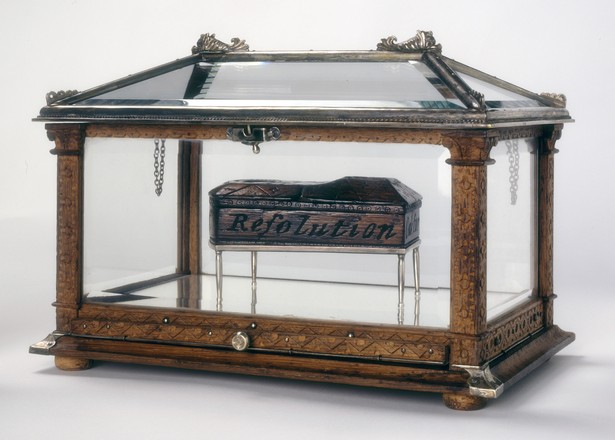Coffin-shaped ditty box
1779
Carved wood inlaid with mother-of-pearl shell, silver stand
Bequest of Sir William Dixson, 1952
DR 2
‘A labour of love’
Cook’s sudden, violent death caused profound shock and grief among his crew. During the homeward voyage, sailors on board HMS Resolution carved this tiny coffin-shaped ditty-box from a fragment of the ship’s timber. It holds a lock of Cook's hair and a watercolour sketch of his last moments alive.
On the ship’s return to England, the ditty-box was presented to Cook’s widow Elizabeth. It was then passed on to members of her family, along with the story of how it was made. The ditty-box eventually came into the possession of Thomas Hart, who in 1912 recorded the story in a written statement, which he placed in a sliding compartment in its base:
‘One week after Captain Cook’s murder his head was brought to the ship by a native chieftain the mutilated and mortified head the horrified ships company recognised their beloved Captain’s features. A few locks of hair were snipped off and the head swathed in linen was placed into a box hurriedly made by the Carpenter. This was heavily weighted and with … the tears of the crew consigned to the sea.
‘On the long homeward voyage … this box was made to preserve the tress of hair. It was a labour of love for each one to add his portion and naturally a coffin-shaped “diddy-box” suggested itself as being appropriate. One dug out the centre, two or three carved various parts, others beat out coins for the plates or ground the flaps into place to enclose and cover the hair and picture drawn by a crew member … Originally is also contained buttons, braid and tokens of or relating to Captain Cook. It was presented to Mrs Cook on arriving in England, where possibly the engraving was done or deepened.’
In the short space of one hour
Cook’s third
voyage of discovery set out to locate the North-West Passage, an ice-free sea
route linking the Atlantic Ocean to the Pacific. Stopping at the island of
O’why’he (Hawaii) for the second time, relations with the local people soured
following a series of thefts. On the morning of 14 February 1779, Cook and ten
of his men went ashore in an attempt to take the Hawaiian king Terreeoboo
hostage.
In the
confusion, shots were fired and one of the high-ranking chiefs, Kalimu, was
killed. As the onlookers responded in anger, Cook and the marines tried to
return to their boats but were attacked on the beach. Cook fired his gun and
killed a Hawaiian warrior. In retaliation, he was struck on the head by a club
and stabbed by an iron dagger. Four marines and 17 Hawaiians were also killed.
First
lieutenant on the Discovery, James
Burney, recorded in his diary that ‘the whole affair, from Capt’n Cook leaving
the Resolution to the return of the
boats, happened in the short space of one hour’.*
From the journal of First
Lieutenant James Burney, 14 February 1779
Footnotes
* James Burney, Journal on HMS
Discovery, vol 3, p 258, ML Safe 1/64
Last written words
The last
entry in Cook’s journal is dated Sunday 17 February 1779:
‘… Mr Bligh returned and reported that he had found a bay in which was
good anchorage and fresh water tolerable easy to come at, into this bay I
resolved to go to refit the Ships and take in water. As the night approached
the Indians retired to the shore, a good [many] however desired to Sleep on
board, curiosity was not their only Montive, at least not with some of them,
for the next Morning several things were Missing which determined me not to
entertain so many another night …’
From the journal of Captain James Cook, 17 February 1779We heard the firing
‘… we heard the firing of
Muskets on shore which was followed by
the Resolutions Pinnace and Launch
firing - with Glasses we could see Capt'n. Cook receive a Blow from a Club and
fall off a Rock into the Water. The Ships then fired, but at too great a distance
to make certain of any particular mark. The Boats soon after came off with an
account that Captain Cook and 4 of the Marines were killed and their Bodies in
possession of the Indians.’*
From the journal of First Lieutenant James Burney, 14
February 1779
Footnotes
* James Burney, Journal on HMS
Discovery , vol 3, p 255, ML Safe 1/64



 Back to list
Back to list